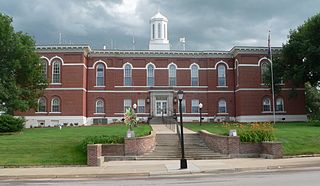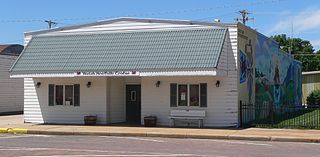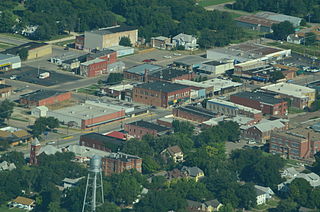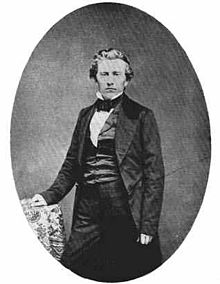
Lancaster County is a county located in the U.S. state of Nebraska. As of the 2020 United States Census, the population was 322,608, making it the second-most populous county in Nebraska. Its county seat is Lincoln, the state capital. The county was created in 1859.

Otoe County is a county in the U.S. state of Nebraska. As of the 2020 United States Census, the population was 15,912. Its county seat is Nebraska City. The county was formed in 1854, and was named tor the Otoe Indian tribe.

Douglas County is a county located in the U.S. state of Nebraska. As of the 2020 United States Census, the population is 584,526. It is the state's most populous county, home to well over one-fourth of Nebraska's residents. Its county seat is Omaha, the state's largest city. The county was established in 1854 and named after Stephen A. Douglas (1813–1861), who was then serving as Senator from Illinois.

Boyd County is a county in the U.S. state of Nebraska. As of the 2020 United States Census, the population was 1,810. Its county seat is Butte. The county was formed in 1891 and named after James E. Boyd, the governor of Nebraska at the time.

Holt County is a county located in the northwestern portion of the U.S. state of Missouri. As of the 2020 census, the population was 4,223. It's county seat is Oregon. The county was organized February 15, 1841. Originally named Nodaway County, it was soon renamed for David Rice Holt (1803–1840), a Missouri state legislator from Platte County.

Maple Hill is a city in Wabaunsee County, Kansas, United States. As of the 2020 census, the population of the city was 631.

Rich Hill is a city in southern Bates County, Missouri, and is part of the Kansas City metropolitan area within the United States. The population was 1,232 at the 2020 census.

Washington is a city on the south banks of the Missouri River, 50 miles west of St. Louis, Missouri, and the largest in Franklin County, Missouri, United States. The estimated population in July 2021 was 14,916, an increase of 7% since the 2010 census. It is the corncob pipe capital of the world, with Missouri Meerschaum located on the riverfront.

Bernie is a city in southern Stoddard County, Missouri, United States. The population was 1,958 at the 2010 census.

Louisville is a city in northern Cass County, Nebraska, United States. The population was 1,319 at the 2020 census.

Exeter is a village in Fillmore County, Nebraska, United States. The population was 516 at the 2020 census.

Wymore is a city in Gage County, Nebraska, United States. The population was 1,377 at the 2020 census.

Brownville is a village in Nemaha County, Nebraska, United States. The population was 142 at the 2020 census.

Rulo is a village in Richardson County, Nebraska, United States. The population was 144 at the 2020 census.

Bellevue is a suburban city in Sarpy County, Nebraska, United States. It is part of the Omaha–Council Bluffs metropolitan area, and had a population of 64,176 as of the 2020 census, making it the 3rd most populous city in Nebraska, behind Omaha and Lincoln, and the second largest city in the U.S. named "Bellevue," behind Bellevue, Washington.

Ceresco is a farming village in Saunders County, Nebraska, United States. The population was 919 at the 2020 census. It is located near U.S. Highway 77, just north of Lincoln, just south of Wahoo, and a short distance southwest of Omaha.

Herington is a city in Dickinson and Morris counties in the U.S. state of Kansas. As of the 2020 census, the population of the city was 2,109.

Windsor is a city in Henry and Pettis counties, Missouri, United States. The population was 2,901 at the 2010 census.

Trumbull is a village in Clay and Adams counties in Nebraska, United States. The population was 198 at the 2020 census. It is part of the Hastings, Nebraska Micropolitan Statistical Area.

Newman Grove is a city in Madison and Platte counties in Nebraska, United States. The population was 721 at the 2010 census.
























